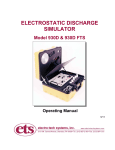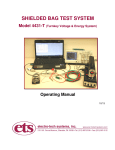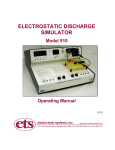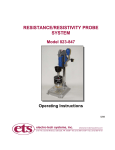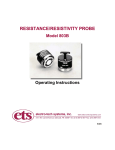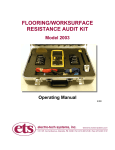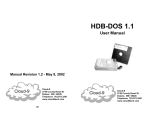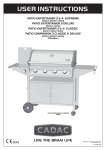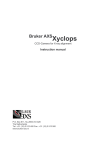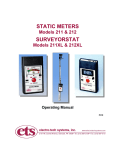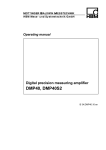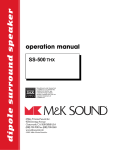Download 9902 Probe User Manual
Transcript
REMOTE DISCHARGE PROBE MODEL 9902 Operating Instructions 10/10 IMPORTANT SAFETY INSTRUCTIONS (Equipment containing HV) The equipment described in this Manual is designed and manufactured to operate within defined design limits. Any misuse may result in electric shock or fire. To prevent the equipment from being damaged, the following rules should be observed for installation, use and maintenance. Read the following safety instructions before operating the instrument. Retain these instructions in a safe place for future reference. POWER POWER CORD: Use only the power cord specified for this equipment and certified for the country of use. If the power (mains) plug is replaced, follow the wiring connections specified for the country of use. When installing or removing the power plug hold the plug, not the cord. The power cord provided is equipped with a 3-prong grounded plug (a plug with a third grounding pin). This is both a safety feature to avoid electrical shock and a requirement for correct equipment operation. If the outlet to be used does not accommodate the 3-prong plug, either change the outlet or use a grounding adapter. FUSES: Replace fuses only with those having the required current rating, voltage and specified type such as normal blow, time delay, etc. DO NOT use makeshift fuses or short the fuse holder. This could cause a shock or fire hazard or severely damage the instrument. POWER LINE VOLTAGE (MAINS): If the line (mains) voltage is changed or isolated by an autotransformer the common terminal must be connected to the ground (earth) terminal of the power source. OPERATION CAUTION Equipment designed to simulate a high voltage electrostatic discharge such as the Series 900 ESD Simulators and the Model 4046 Static Decay Meter utilize voltages up to 30kV. The basic nature of an ESD event will result in electromagnetic radiation in addition to the high level, short duration current pulse. Therefore, personnel with a heart pacemaker must not operate the instrument or be in the vicinity while it is being used. DO NOT OPERATE WITH COVERS OR PANELS REMOVED. Voltages inside the equipment can be as high as 30kV. In addition, equipment may contain capacitors up to 200pF charged to 2kV. Capacitors can retain a charge even if the equipment is turned off. DO NOT OPERATE WITH SUSPECTED EQUIPMENT FAILURES. If any odor or smoke becomes apparent turn off the equipment and unplug it immediately. Failure 1 to do so may result in electrical shock, fire or permanent damage to the equipment. Contact the factory for further instructions. DO NOT OPERATE IN WET/DAMP CONDITIONS: If water or other liquid penetrates the equipment, unplug the power cord and contact the factory for further instructions. Continuous use in this case may result in electrical shock, fire or permanent damage to the equipment. DO NOT OPERATE IN HIGH HUMIDITY: Operating the equipment in high humidity conditions will cause deteriation in performance, system failure, or present a shock or fire hazard. Contact the factory for further instructions. DO NOT OPERATE IN AREAS WITH HEAVY DUST: Operating the equipment in high dust conditions will cause deteriation in performance, system failure, or present a shock or fire hazard. Contact the factory for further instructions. DO NOT OPERATE IN AN EXPLOSIVE ATMOSPHERE: Operating the equipment in the presence of flammable gases or fumes constitutes a definite safety hazard. For equipment designed to operate in such environments the proper safety devices must be used such as dry air or inert gas purge, intrinsic safe barriers and/or explosion-proof enclosures. DONOT USE IN ANY MANNER NOT SPECIFIED OR APPROVED BY THE MANUFACTURER: Unapproved use may result in damage to the equipment or present an electrical shock or fire hazard. MAINTENANCE and SERVICE CLEANING: Keep surfaces clean and free from dust or other contaminants. Such contaminants can have an adverse affect on system performance or result in electrical shock or fire. To clean use a damp cloth. Let dry before use. Do not use detergent, alcohol or antistatic cleaner as these products may have an adverse affect on system performance. SERVICE: Do not attempt to repair or service the instrument yourself unless instructed by the factory to do so. Opening or removing the covers may expose you to high voltages, charged capacitors, electric shock and other hazards. If service or repair is required, contact the factory. 2 1.0 INTRODUCTION The ETS Model 910 Electrostatic Discharge Simulator evaluates the ESD suceptability of electronic devices using either the Human Body (HBM) or the Machine (MM) Models. The Human Body Model utilizes a 100pf capacitance discharged through a 1500 Ohm resistor up to ±8kV over 2 ranges. The LO Range generates discharge pulses from approximately 5 Volts to 2000 Volts with a resolution of 1 Volt. The HI Range generates discharge pulses from approximately 30 Volts to 8000 Volts with a resolution of 10 Volts. The Machine Model uses a 200pf capacitance discharged through 0 Ohms and operates only in the LO Range. The Charged Device Model (CDM) is when the device itself is slowly charged and then discharged to ground is available as an option. All discharges functions are performed using the 6” (154mm) discharge cables that plug into the Simulator front panel. There are certain applications where it is desired to apply an ESD pulse to devices that either may not conveniently fit onto one of the Model 910 discharge modules or added to an automatic pick and place test set up. The ETS Model 9902 is a remote probe that operates only in the LO Range (up to 2000V) for all discharge Models. The Model 910 must be modified to provide the necessary signals to operate the Probe. The Probe shown in Figure 1.0-1 can be used as a handheld device or with the addition of remote cables, be attached to an automatic test system. Figure 1.0-1: Model 9902 Remote Discharge Probe 3 2.0 DESCRIPTION The Model 9902 is housed in an aluminum tube measuring 8.0” (203mm) long by 1.25” (32) diameter. It includes a removable discharge head with a replaceable spring-loaded pointed discharge tip and a set of 12” long discharge cables that are terminated with standard 0.161” (4mm) banana plugs plus a pair of springloaded adapters with pointed spring-loaded discharge tips for attachment to a pick and place or remote test set up. Red and Black 0.5” (6mm) jumpers are provided to select the HBM, MM and CDM functions. A spare set is also included. The Remote Probe is connected to the Model 910 via an 8.5’ (2.5m) cable assembly that consists of high voltage, ground and control signal leads. The supplied assembly is shown in Figure 2.0-1. Figure 2.0-1: Model 9902 plus accessories Each discharge function requires its own unique set of cables in order to achieve the required waveform. This will be covered in detail in Section 3.0 SET UP. A manual remote discharge button is also included in the Remote Probe assembly. When the discharge head is used the position of the white dot indicates which function the discharge tip is connected. 4 3.0 SET UP The Model 9902 MUST ALWAYS BE HELD OR MOUNTED VERTICALLY. The assembly contains mercury-wetted relays that operate only in the vertical mode. However, when holding the Probe it may be offset by as much as 30 degrees from the vertical and still operate satisfactorily. 3.1 Connection to Model 910 The Model 910 MUST BE MODIFIED at the factory in order for the Model 9902 Remote Discharge Probe to operate. Figure 3.0-2 shows the Probe connections to the rear panel of the Simulator. Figure 3.0-1: Probe connection to Model 910 (modified) As an option, the Model 910 can also be modified to receive a 5V electronic discharge pulse from a computer or other device. When so equipped a BNC connector is added to the rear panel next to the 5-pin DIN Remote Probe control signal connector. 3.2 Application The Model 9902 may be used either by holding the Probe and using the remote discharge button, as shown in Figure 3.0-2, or mounting it to a holding fixture. When mounted to a holding fixture either the discharge head or the remote cable and adapter assemblies can be used. However, for the HBM function each configuration requires a different cable configuration. 5 Figure 3.0-2: Holding Remote Probe 3.3 Function Selection The discharge waveform from an ESD simulator is very sensitive to stray capacitance and inductance. This is especially true with the HBM network. In a standard simulator such as the Model 910 these parameters are essentially fixed. However, with a remote discharge set up these parameters can vary thus affecting the discharge waveform, usually the amount of ringing measured. Holding the Probe causes more ringing than using the remote cable set up. Some of this ringing can be addressed by using additional filtering in the ground cable. The following hook ups for each different function will produce the best waveform for the particular set up. 3.3.1 HBM Testing Holding Probe Figure 3.0-3 shows the Probe set up for HBM testing with the operator either holding the Probe or with the Probe physically mounted to a fixture. Follow the following procedure: 6 HBM/MM select jumper Ground CDM/HBM & MM select jumper Align white dot with HBM position 3.0-3: Probe set up for HBM handheld or fixed testing 1. 2. 3. Select the HBM function by plugging the Black jumper into the HBM 0.040” pin jacks and the Red jumper into the unmarked pin jacks. Select the HBM output by removing the Discharge Head and plugging into the position where the white dot lines up with HBM. Plug the 12” black lead with Black banana plug into the Black banana jack on the reverse side of the Probe for ground. 3.3.2 MM Testing Holding Probe Refer to Figure 3.0-4 Machine Model set up. 1. 2. 3. Select the MM function by plugging the Black jumper into the MM pin jacks and the Red jumper into the unmarked pin jacks. Select the MM output by removing the Discharge Head and plugging it into the position where the white dot lines up with MM. Plug the 12” black lead with Green banana jack into the black banana jack on the reverse side of the Probe for ground. 7 HBM/MM select jumper CDM/HBM & MM select jumper Ground Select MM Figure 3.0-4: Probe set up for MM handheld or fixed testing 3.3.3 CDM Testing Holding Probe When using the Probe with the Discharge Head the Probe can only perform the charge function through the pin tip. An external ground lead must be applied to the device to perform the discharge function. The discharge waveform is extremely sensitive to the length of the ground lead. The 12” ground lead will result in a rise time of approximately 4-6 nsec while a very short lead (<2” or 50mm) will result in a rise time of <1 nsec. Refer to Section 4.1.3 Waveform Verification for typical CDM waveforms. Refer to Figure 3.0.5 for CDM testing using the Remote Probe to and an external lead to perform the Charge/Discharge functions and follow the procedure below. 1. 2. The Function jumpers are not used in this configuration. Select the CDM output by removing the Discharge Head and plugging it into the position where the white dot lines up with CDM. 8 3. Use either the Black ground wire with the Green banana plug or other suitable lead to manually contact the device to initiate a discharge. Figure 3.0-5: CDM Probe configuration using Discharge Head 3.3.4 HBM Testing Using External Cables Remove the Discharge Head. Three banana jacks will be visible. Install the Probe at a convenient location within 12” (305mm) of where the device will be tested. Install the Discharge Pin Adapters at the desired location. Refer to Figure 3.0-6 and proceed as follows: 1. Select the HBM function by plugging the Black jumper into the HBM 0.040” pin jacks and the Red jumper into the unmarked pin jacks. 2. Select the HBM output by plugging the Red 12” lead with Red banana plug into the jack that lines up with HBM designation on the housing. 3. Plug the 12” black lead with the Green banana plug into the Black banana jack on the reverse side of the Probe for ground. 4. Plug both cables into the Discharge and Ground Pin Adapters. . 9 Figure 3.0-6: HBM test set up using external leads 3.3.5 MM Testing Using External Cables Remove the Discharge Head. Three banana jacks will be visible. Install the Probe at a convenient location within 12” (305mm) of where the device will be tested. Install the Discharge Pin Adapters at the desired location. Refer to Figure 3.0-7 and proceed as follows: 1. Select the MM function by plugging the Black jumper into the MM 0.040” pin jacks and the Red jumper into the unmarked pin jacks. 2. Select the MM output by plugging the Red 12” lead with White banana plug into the jack that lines up with MM designation on the housing. 3. Plug the 12” black lead with the Green banana plug into the Black banana jack on the reverse side of the Probe for ground. 4. Plug both cables into the Discharge and Ground Pin Adapters. 3.3.6 CDM Testing Using External Cables for Charge/Discharge Functions Remove the Discharge Head. Three banana jacks will be visible. Install the Probe at a convenient location within 12” (305mm) of where the device will be tested. Install the Discharge Pin Adapters at the desired location. Refer to Figure 3.0-8 and proceed as follows: 10 1. Select the CDM function by leaving the Black jumper in either the HBM or MM 0.040” pin jacks and the Red jumper into the CDM pin jacks. 2. Select the CDM output that is used to charge the device by plugging the Red 12” lead with White banana plug into the jack that lines up with CDM designation on the housing. 3. Plug the 12” black lead with the Green banana plug into the banana jack that lines up with the MM designation on the housing. (When the CDM function is selected the discharge relay is configured to switch to ground when a Discharge is initiated.) MM CDM Figure 3.0-8: CDM with Probe performing Charge/Discharge 3.3.7 CDM Testing Using Short Ground Lead This test is similar to that described in Section 3.3.3 except the 12” Red lead with white banana plug is used to charge and the grounding or discharge function is done externally as shown in Figure 3.0-9. 11 Figure 3.0-9: CDM set up using external discharge ground lead 4.0 TEST PROCEDURES The Charge/Discharge functions of the Model 9902 Remote Probe can be performed using the controls on the front panel of the Simulator or by just depressing the Red Remote Discharge pushbutton on the Probe. The Probe can remain connected if normal Model 910 testing is to be performed. When using the Remote Discharge button the Green and Yellow Charge Discharge LED indicators on the front panel do not function in the normal manner and should be ignored. 4.1 Waveform Verification The various ESD simulator specifications require waveform verification of the discharge pulse. As mentioned previously the waveform measured is a function of probe, lead and current transducer placement. The following sections show typical waveforms obtained using the various test set ups described above. It is seen that the test set up, especially the lead capacitance and placement affects the HBM waveform ringing and the peak amplitude of the MM. The waveform characteristics can be altered somewhat by adjusting lead placement and/or voltage level to bring the waveform into or close to compliance. 12 4.1.1 HBM @ 2000V to Ground Discharge using 12” leads Discharge using Discharge Head 4.1.2 MM @ 400V to Ground Discharge using 12” leads Discharge using Discharge Head 4.1.3 CDM Discharge with 12”& Short Leads @ 400V Charge/Discharge using relay & 12” leads Manual Discharge using 12” ground lead 13 Manual discharge using short (2”) ground lead CDM measurement was made by charging a 15pf, 3kV capacitor and then discharging it to ground using the various configurations described above. 5.0 REPAIR AND MAINTENANCE 5.1 Repair The Model 9902 Remote Discharge Probe cannot be serviced by the user. It must be returned to ETS for repair. Contact ETS at 215-887-2196 ext 220 to obtain an RMA number. 5.2 Discharge Contact Pins The Model 9902 Remote Discharge Probe utilizes gold-plated, springloaded, point tip pins as the contact electrode. Each pin requires 5 oz (688 gr) of force for total compression. The electrodes are installed in sockets for easy replacement. ETS currently stocks S4A, S4C, S4F S4H and S4K contact electrodes. Other electrode configurations, shown in Figure 5.0-1, such as smaller diameter, conical, and conductive rubber contact surfaces are available as options. Figure 5.0-1: - Available spring-loaded electrodes 14 6.0 WARRANTY Electro-Tech Systems, Inc. warrants its equipment, its accessories and parts of its manufacture to be and remain free from defects in material and workmanship for a period of one (1) year from the date of invoice, and will, at the discretion of Seller, either replace or repair without charge, F.O.B. Glenside, similar equipment or a similar part to replace any equipment or part of its manufacture which, within the above stated time, is proved to have been defective at the time it was sold. All equipment claimed defective must be returned properly identified to the Seller (or presented to one of its agents for inspection). This warranty only applies to equipment operated in accordance with Seller's operating instructions. Seller's warranty with respect to those parts of the equipment that are purchased from other manufacturers shall be subject only to the manufacturer's warranty. Seller's liability hereunder is expressly limited to repairing or replacing any parts of the equipment manufactured by the manufacturer and found to have been defective. Seller shall not be liable for damage resulting or claimed to result from any cause whatsoever. This warranty becomes null and void should the Resistance/Resistivity Kit, or any part thereof, be abused or modified by the customer of if used in any application other than that for which it was intended. This warranty to replace or repair is the only warranty, either expressed of implied or provided by law, and is in lieu of all other warranties and the Seller denies any other promise, guarantee, or warranty with respect to the equipment or accessories and, in particular, as to its or their suitability for the purposes of the buyer or its or their performance, either quantitatively or qualitatively or as to the products which it may produce and the buyer is expected to expressly waive rights to any warranty other than that stated herein. ETS must be notified before any equipment is returned for repair. ETS will issue an RMA (Return Material Authorization) number for return of said equipment. Large equipment should be shipped in the original packaging. If this is not possible, the equipment should be packed in a sufficiently large box of double wall construction with substantial packing around all sides. A description of the problem along with the contact name and telephone number must be included in formal paperwork and enclosed with the instrument. Electro-Tech Systems, Inc. will not assume responsibility for additional cost of repair due to damage Incurred during shipment as a result of poor packaging. 10/10 15
















